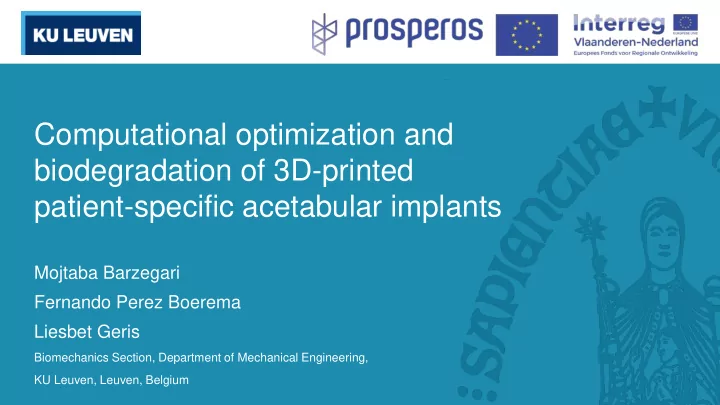

Computational optimization and biodegradation of 3D-printed patient-specific acetabular implants Mojtaba Barzegari Fernando Perez Boerema Liesbet Geris Biomechanics Section, Department of Mechanical Engineering, KU Leuven, Leuven, Belgium
Disclosure Authors declare to have no conflict of interest. 2
Patient-specific 3D Printed Implants • Gaining popularity in recent years • Acetabular implants • Design optimization • Optimizing mechanical stability • Considering biodegradation behavior (Source: 3D Systems Inc.) 3
Bone Resorption in Current Implants • Underloading of the bone leads to Resting Bone bone resorption • Mismatch between the bone and the implant stiffness causes implant failure Bone Resorption Mineralization Osteoporotic Bone Normal Bone Reversal Bone Formation (Algaecal, 2017, Encyclopedia Britannica Inc, 2013; adike, Shutterstock) 4
Bone Removal in Revision Surgeries • Implants should be removed at the end of their lifetime • Some extra bone is also removed along with the implant • Making at least part of the implant from biodegradable materials (Source: 3D Systems Inc.) 5
Problem Definition • Challenges: • Optimization of material properties of the implant • Tuning the biodegradation behavior • Can be solved by: • Topology optimization of the implant • Mathematical modeling of biodegradation 6
Create 3D model of the biodegradable Model Workflow part of the implant Construct the computational Digitally reconstruct bone defect Create computer model model of the joint Biodegradation Derive 3D bone geometry Optimization Optimize implant design Collect patient’s data Simulate the biodegradation behavior of the implant Print optimized implant Patient 7
Topology Optimization • Two patient-specific models • Maximize the long-term implant stability • The difference of Strain Energy Density is used to evaluate the performance of the designs during the optimization 8
Mathematical Model of Biodegradation The model captures: 1. The chemistry of dissolution of metallic implant 2. Formation of a protective film 3. Effect of ions in the medium (1) (2) (3) H 2 H 2 O Mg 2+ OH − Cl − Mg 2+ 𝑓 − Mg 2+ OH − Mg OH 2 Mg OH 2 Mg Mg Mg 9
Optimization Results <<1 >50% |Δσ | Bone volume ρ Stress shielding Stress increase 0 0 -1 -0.2 0 0.2 1 Δσ
Biodegradation Results 11
Experimental Data and Model Calibration (Abidin et al., Corrosion Science, 2013) 12
Conclusion • We have developed in-silico models to investigate • Reduction of implant-induced stress shielding • Partially replacement of the implant over time • Once validated and coupled, the models will serve as an important tool to find the appropriate biodegradable implant designs 13
Thank you for your attention This research is financially supported by the PROSPEROS project, funded by the Interreg VA Flanders - The Netherlands program
Recommend
More recommend